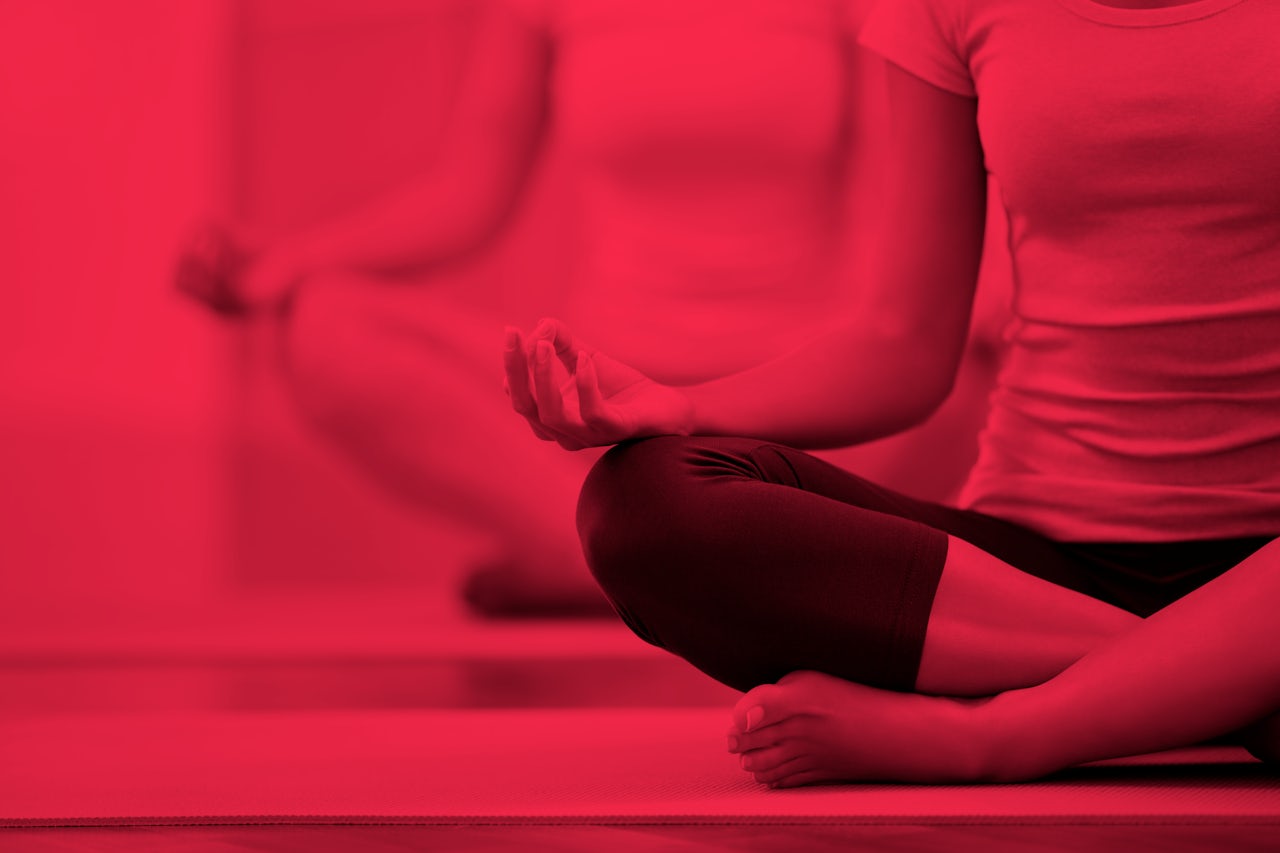I am in a room lit in purple, on a gray rubber yoga mat, listening to vaguely familiar classical music as a woman dressed in all black counts down five, four, three, two, and live. The instructor of my 10 a.m. class swivels her face towards the cameras behind me, now live-streaming a 30-minute restorative flow to hundreds of subscribers. She thanks individual users by name — username? — for being there that Friday morning, for making space for themselves, in the gentle tones familiar to anyone who’s ever taken a $10 introductory yoga class at their neighborhood studio. But as I move from a comfortable seated position into a child’s pose, I am acutely aware that I am not in my neighborhood yoga studio. I am at a live Peloton class in the fitness company’s West Village studio, which produces treadmill and yoga classes for streaming in real time to the brand’s one million subscribers, in order to see what it is like to perform exercise for an audience I cannot see.
Peloton is perhaps best known for its high-end, high-tech stationary bikes, which cost $2,245 (not including the monthly membership of $39 a month). The Peloton model, for the unfamiliar, allows users to follow along with live classes that are beamed into a treadmill or bike’s attached screen, which also tracks your metrics relative to the other people online at the same time. (On a Peloton bike at the gym of a Philadelphia Marriott last fall with Brooklyn Nets host Ally Love as my instructor, I rode a little less than five miles in 20 minutes, placing around 60,000th out of 142,000 people who’d ever taken that class.) The New York-based company raised an astronomical $550 million last August, valuing it at $4.15 billion, and is targeting an IPO possibly this year.
The idea behind Peloton is that it’s like taking your favorite boutique class, only at your house, which is convenient for people who don’t live near a major metro area and a multitude of ClassPass options. For those who don’t have the means to invest in the at-home bike or treadmill (which amounts to more than $4,000 for the basic model), in June 2018 the brand introduced a digital membership for only $19.49 a month, which lets users access guided workouts like yoga, cardio, or strength through an app.
I’m not a yoga snob — okay, I’m a little bit of a yoga snob — but while I was sitting in a supported pigeon, I was hit by a wave of cognitive dissonance. In its modern, Western interpretation, yoga is an exercise in aligning the mind and the body. And yet, the purpose of my physical presence in that yoga studio was to — literally — flesh out the virtual class experience for someone paying between $20 and $40 a month for it. (Full disclosure: I attended the class at Peloton’s invitation as a member of the press.) What gave me pause wasn’t the sense of futurity brought on by the lighting, the countdown, the Kubrickian soundtrack. The class made me wonder about how sustainable it really is to create virtual space for physical experience, especially for something like exercise that can’t be transposed online, no matter how many barre-mirror selfies you tap through in your Instagram stories.
This isn’t and will never be an issue for the vast majority of Peloton users, who comfortably take these classes alone in their homes. Twenty new classes are uploaded daily, and there are “instructor-curated training programs.” But the real appeal of the app, especially compared with the superabundance of free yoga videos on YouTube, is meant to be certain production value that the vast majority of yoga YouTubers can’t achieve, thanks to a physical production studio.
I found myself thinking about this while looking up at a giant clock counting down the minutes left in the class in bright red digital numbers. I wondered if the cameras would catch my chin doubling into itself as I moved in and out of cat-cow, or how disruptive it would be if I sneezed — things I never think about in my day-to-day yoga practice. The instructor couldn’t get up from her own mat to gently adjust my downdog, because that would mean breaking eye contact with the livestream.
There is a community created when an instructor calls remote Peloton customers out by username, or in the myriad private Facebook groups devoted to the culty workouts. But part of the basic privilege of working out in a group is being completely rooted in your own body, and simultaneously part of a hive mind. Each person in the class holds one more pose, two more breaths, 10 more seconds, in step together. There is a partnership in holding space alongside a stranger, even if it’s just to glance over to them to make sure you both have your right foot forward in a lunge. The feeling was lost entirely to me, and I was right there in the room; I’ll never know, I suppose, how well I simulated a oneness of purpose for all the viewers at home.
Peloton is just one of many companies testing the lengths to which a live “community” can be beamed into peoples homes. There’s the Mirror, a training screen that’s designed to blend seamlessly into your living room, or the Hydrow Rower, a smart erg with a display that shows what it’d be like if you were actually at Head of the Charles. And as more people move into jobs with flexible hours or the ability to work from home (one perk of the gig economy), my guess is that there will only be more kinds of these machines available. But what each of these experiences have in common is that they transport the user out of their body, and into a liminal space where everything is trackable, quantified, measured; everything except for maybe the most important part: the articulated joy of movement and strain.
